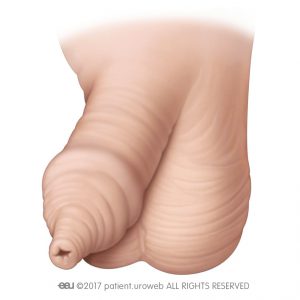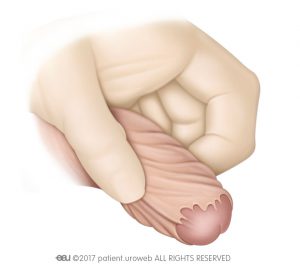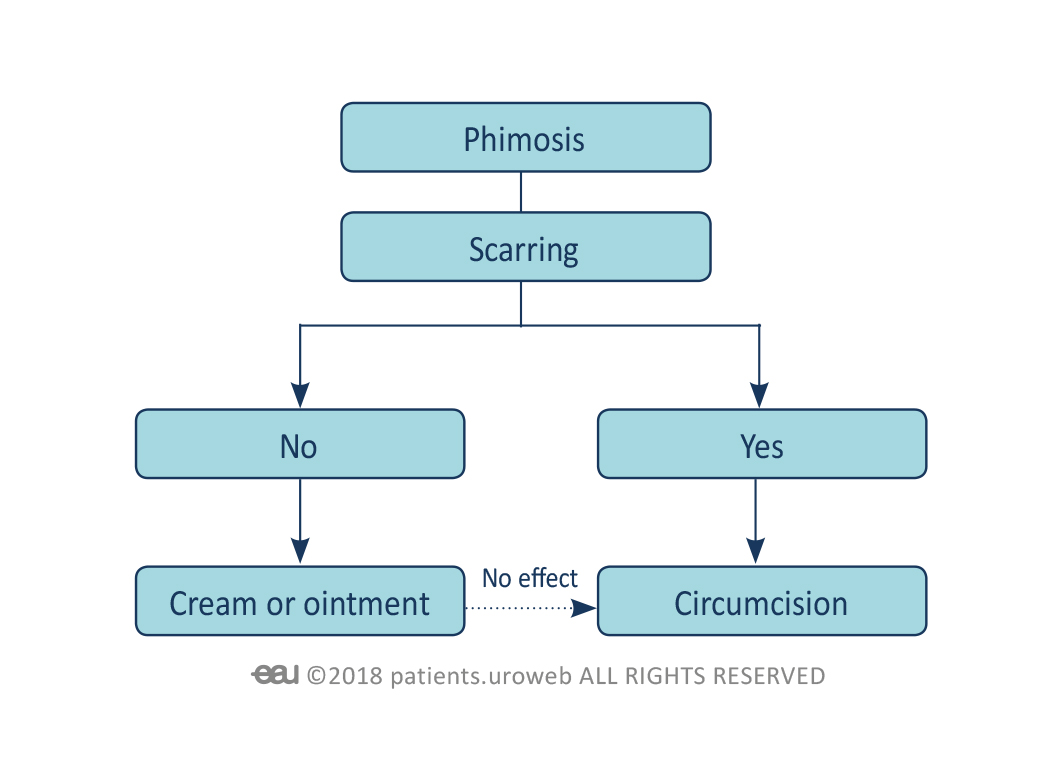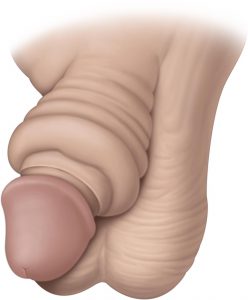Table of Contents
What is phimosis?
Phimosis is the inability to pull the foreskin back over the head of the penis (glans).
The head of penis is covered by a tissue called the foreskin. The foreskin is usually loose and slides easily over the head of the penis. This movement allows the child to urinate or to become fully erect (in adolescents). Sometimes, though, the foreskin is too tight. It can close over the glans and become unable to move (Fig. 1). This condition is called phimosis.
Symptoms of phimosis
Phimosis typically becomes a problem when symptoms occur. Symptoms include:
- Redness, soreness, or swelling of the foreskin
- Ballooning of the foreskin while urinating
- Inability to fully pull back the foreskin by age 3 or older
- Inflammation of the head of the penis
- Thick discharge under the foreskin
If your child has any of these symptoms, take him to see the doctor.
Diagnosis of phimosis
The diagnosis of phimosis is relatively simple. The doctor will do a physical exam, which consists of assessment of your child´s penis and testes. The doctor may ask some questions:
- How long have there been problems with the foreskin?
- Has the foreskin been red or sore?
- Does your child take any medication?
- Does your child have diabetes?
The doctor may ask parent(s) to be present or to help during the examination, particularly for younger children and infants.
How is phimosis treated?
Phimosis is not life threatening, but the symptoms are uncomfortable. Treatments include:
- Topical steroid for phimosis without scarring
- Surgical removal of the foreskin (circumcision)
Steroid cream or ointment to loosen the tight foreskin is successful in most cases. Your doctor will show you how to apply the ointment to the tight skin. The ointment softens the foreskin when used every day for 4-8 weeks. Your doctor will also show you how to massage and manually stretch the foreskin. Stop using the ointment once the foreskin can be pulled all the way. This treatment has few or no side effects.
If there is scarring from an earlier injury, infection or skin disease, in some cases, circumcision may be needed.
General information about phimosis
How common is phimosis?
Physiological phimosis becomes less common with age. The foreskin can be pulled back behind the glans in about half of 1-year-old boys and in nearly 90% of 3-year-olds. Less than 1% of boys aged 16 – 18 years have physiological phimosis.
What causes phimosis?
Phimosis is natural in very young male children. In older boys, phimosis might be caused by damage or scarring. It is more likely to occur in boys with:
- Urinary tract infections that keep coming back
- Infections of the foreskin
- Repeated rough handling of the foreskin
- Trauma that affected the foreskin
Paraphimosis
Paraphimosis is an emergency that can happen only in uncircumcised boys. The tight foreskin is pulled back behind the head of the penis and becomes stuck (Fig. 4). It cannot be returned to its normal position. This leads to swelling of the head of the penis and the foreskin. In severe cases, blood cannot get to the head of the penis and can cause tissue to die. Paraphimosis can cause blackening and/or hardening of the head of the penis that can eventually lead to structural changes.
Important: If you think that your child has paraphimosis, contact your doctor immediately.
Symptoms include:
- Swelling at the penis tip when the foreskin is pulled back
- Penile pain
- Not being able to move the foreskin back over the head of the penis
- Discolouration at the tip of the penis (skin is dark red or bluish)
Emergency treatment
The doctor will press the swollen tissue of the penis and try to move the tightened foreskin over the head of the penis. If this does not work, your doctor might:
- Inject the foreskin with the enzyme hyaluronidase to try to loosen the foreskin
- Make a small surgical cut to loosen the foreskin
- Recommend an emergency circumcision
Living with phimosis
A tight foreskin (phimosis) results from the structure of the penis. It will not go away on its own, but it is not considered a problem unless symptoms occur. Cleaning under the foreskin will help prevent infection and keep the skin loose. If the foreskin becomes stuck and cannot be pulled back over the glans, contact your doctor immediately. If phimosis is treated with circumcision, the foreskin will be removed. No lingering effects are expected.





